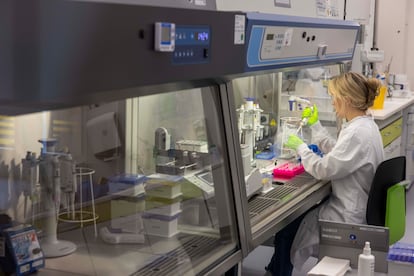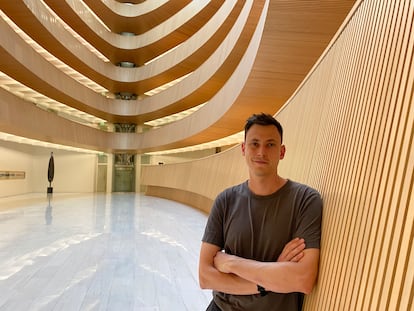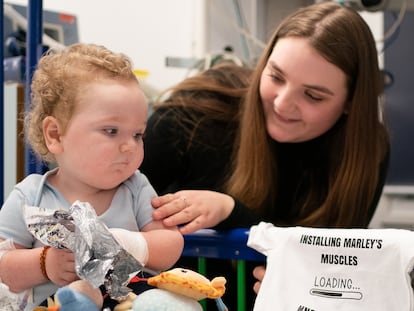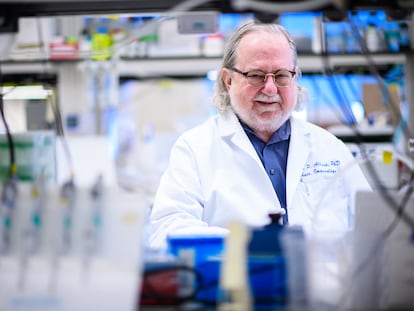Why cancer treatments can cost up to three times more than other drugs
A study show that pharmaceutical companies charge higher prices for these therapies, draining resources from other diseases

Public health officials often face the decision of how to best allocate taxpayer money. Ideally, buying medicines that cure every ailment would be the clear answer. However, the reality is more complex. Not all diseases have effective therapies, new treatments are costly, and budgets are always tight. Therefore, the best strategy is to invest in what benefits the population’s health the most. This involves prioritizing drugs that increase life expectancy, enhance well-being, and serve unmet medical needs.
A recent research study in eClinicalMedicine conducted by experts from the Memorial Sloan Kettering Cancer Center in New York and the University of Zurich has identified an additional challenge in this complex equation: the cancer premium. Miquel Serra, co-author of the paper and a health economics and epidemiology researcher at the University of Zurich said, “New cancer drugs tend to be up to three times more costly compared to drugs for other diseases, even when considering equivalent efficacy for conditions with similar incidence and mortality rates. This price disparity cannot be solely attributed to these factors or to higher research and development expenses.”

The study found that the cancer premium is almost universal. The researchers observed it in three countries that are representative of the most common public policies regarding pharmaceuticals. In the United States, where there is no public healthcare system, companies are free to set drug prices. In Germany, the public health system initially agrees to pay what companies ask and renegotiates after a year based on the results. In Switzerland, an evaluation is done before accepting a drug into the public health system.
The Swiss system resembles the one in Spain. In general, Spain negotiates slightly lower prices compared to northern European countries. However, experts say there still are variations in costs between oncological and non-oncological treatments. The difference comes from applying discounts to a mostly consistent official public price across Europe.
“The study’s significant finding is the identification of the cancer premium. Regulatory differences account for the considerably higher prices in the United States, slightly higher prices in Germany, and lower prices in Switzerland. However, cancer treatments remain considerably more expensive in all instances,” said Beatriz González López-Valcárcel, a professor of economics at the University of Las Palmas in Spain’s Canary Islands.
According to researchers, the cancer premium has significant implications for equitable access to health care and the sustainability of health systems, especially considering the substantial increase in drug prices. A recent study conducted by Spain’s Ministry of Health shows that hospitals in Spain have experienced a 94% rise in the cost of cancer treatments in just five years (2016-2021).
“The concept of a premium alters efficiency dynamics in health systems. The objective is to allocate resources where they yield the greatest health benefits. However, if cancer treatments need triple the funding for equivalent results, other areas may be neglected. This risks compromising overall population health due to inefficient resource allocation,” said Serra.
“Social injustice raises treatment expenses, diverting resources from other important illnesses in a context where health system sustainability is a concern.”Beatriz González López-Valcárcel, University of Las Palmas, Spain
The researchers analyzed a total of 181 drugs recently launched by the pharmaceutical industry. Out of these, 68 (37.5%) were oncological. Among them, 177 were available in the U.S. market, 116 in Germany, and 93 in Switzerland. Notably, there are significant price differences among the countries. The average price of the new treatments is $49,000 (€45,000) in Switzerland, $63,200 (€58,000) in Germany (29% higher), and almost $100,300 (€92,000) in the U.S. (104% higher).
The researchers have primarily focused on the significant rise in the cost of new drugs in the last decade, particularly among cancer patients. This increase has been more pronounced in all countries, except Germany. In the United States the price of new treatments for other diseases has gone from an average of $26,000 (€24,000) in 2011 to $68,750 (€63,000) in 2020, with an average annual increase of 17.6%. Oncology drugs, on the other hand, have shot up 31% annually, going from $51,000 (€47,000) per drug to $196,400 (€180,000).
In Germany, the costs of non-oncological drugs have increased from $24,000 (€22,000) to $41,400 (€38,000) per year (7.9% annual growth), while cancer-related drugs have risen from $50,200 (€46,000) to $72,000 (€66,000) per year (4.8% annual growth). Similarly, in Switzerland, annual price increases over a decade have been 3% for in non-oncological drugs and 8.1% for cancer drugs.
These data indicate that the cancer premium was around $74,200 (€68,000) per treatment in the United States, $37,650 (€34,500) in Germany, and $32,700 (€30,000) in Switzerland, considering the average of all drugs released in the last decade.
Pricing policy
The pharmaceutical industry’s pricing policies are the primary cause of these disparities. “The industry claims that high prices are attributed to increased cancer research and development costs. However, scientific evidence has proven that drug prices are not correlated with actual expenses. Furthermore, it neglects to consider that a significant portion of initial drug development is financed by the public,” said Jaime Espín, a professor of health economics at the Andalusian School of Public Health and former adviser on drug pricing to the World Health Organization (WHO), the World Bank and the European Commission.
Kerstin Vokinger, a professor at the University of Zurich and co-author of the article, examined the factors that drive health systems to accept these higher prices. “Higher prices for cancer drugs may reflect higher public awareness and fear of oncological disorders compared to other diseases,” he said.
More than research and development costs or treatment effectiveness, social willingness is the main driver of the cancer premium, experts say. This willingness persists despite studies indicating that fewer than half of approved cancer treatments provide substantial therapeutic benefits that enhance patient survival or quality of life.
Serra and Vokinger recently conducted another study published in The BMJ, and found that only 41% of new cancer treatments approved by the U.S. Food and Drug Administration (FDA) provide substantial therapeutic value. This percentage increases to 47% for treatments approved by the European Medicines Agency (EMA). When a drug is approved for a second indication, such as using a therapy for one type of breast cancer to treat another tumor in a different organ, the therapeutic value achieved drops to 34% and 36%, respectively.
“The decreasing effectiveness in the second and third indications has significant implications for health systems. The drug price remains the same despite an increasing number of approved indications for the same treatment [sometimes more than a dozen]. This may divert resources towards less efficient therapeutic options,” said Vokinger.
Public health systems use stringent evaluation processes to determine the therapeutic value of drugs and indications eligible for public financing. In Germany, therapies are made available upon approval by the EMA, followed by a reassessment of their effectiveness after a year. If the observed effectiveness is lower than expected, companies may be asked to reduce prices to continue selling the drug to the public health system. While mechanisms exist to exclude less effective indications from the system, the challenge lies in the fact that all therapies maintain the same price, regardless of their therapeutic value.
“Countries like Spain, France and Switzerland face a dilemma in evaluating drugs for their public health systems. High prices require strict financing and prioritization of more effective indications. However, this limits options in the system. One potential solution is setting different prices based on effectiveness per indication. Spanish law currently prohibits this, but reforms are being studied,” said Espín.
In some cases, health systems allocate more resources to certain pathologies, such as certain types of cancer and rare diseases. This is to promote research and provide therapeutic options for patients with limited treatment choices. This is the reality for certain types of cancer and rare diseases with low incidence rates and limited treatment options. Allocating more resources to these areas promotes research and ensures that patients have viable therapeutic options. “This may explain the reason for the higher cost in certain cases. However, the study shows that it is consistently applied to all anticancer medications, including those with several alternative therapies for tumors that are prevalent in the population,” said González Lopez-Valcarcel.
Jaime Espín highlights two factors to consider when evaluating this type of study. “They provide valuable information, but they do have limitations. First, they are based on the official prices of drugs, which are publicly available. However, healthcare systems often negotiate confidential discounts with companies, resulting in potentially lower actual prices and fewer inefficiencies. Second, public hospitals often purchase in volume, which can provide additional discounts. In some cases, this prompts the purchase of treatments for second indications, even if they are less effective, to lower the average purchase price. It’s important to note that the details of these deals are confidential due to contractual agreements.”
Sign up for our weekly newsletter to get more English-language news coverage from EL PAÍS USA Edition
Tu suscripción se está usando en otro dispositivo
¿Quieres añadir otro usuario a tu suscripción?
Si continúas leyendo en este dispositivo, no se podrá leer en el otro.
FlechaTu suscripción se está usando en otro dispositivo y solo puedes acceder a EL PAÍS desde un dispositivo a la vez.
Si quieres compartir tu cuenta, cambia tu suscripción a la modalidad Premium, así podrás añadir otro usuario. Cada uno accederá con su propia cuenta de email, lo que os permitirá personalizar vuestra experiencia en EL PAÍS.
¿Tienes una suscripción de empresa? Accede aquí para contratar más cuentas.
En el caso de no saber quién está usando tu cuenta, te recomendamos cambiar tu contraseña aquí.
Si decides continuar compartiendo tu cuenta, este mensaje se mostrará en tu dispositivo y en el de la otra persona que está usando tu cuenta de forma indefinida, afectando a tu experiencia de lectura. Puedes consultar aquí los términos y condiciones de la suscripción digital.
More information
Archived In
Últimas noticias
David Bowie, the galactic thinker who encouraged us to break new ground
John Berger and the loss of rural culture
From police officer to bloodthirsty kidnapper: Terror in Mexico during the years of ‘The Ear Chopper’
Alain Aspect, Nobel laureate in physics: ‘Einstein was so smart that he would have had to recognize quantum entanglement’
Most viewed
- David King, chemist: ‘There are scientists studying how to cool the planet; nobody should stop these experiments from happening’
- Reinhard Genzel, Nobel laureate in physics: ‘One-minute videos will never give you the truth’
- Oona Chaplin: ‘I told James Cameron that I was living in a treehouse and starting a permaculture project with a friend’
- Mexico completes its trade shift with the entry into force of tariffs on China and countries without trade agreements
- Sinaloa Cartel war is taking its toll on Los Chapitos











































